Creativity Unleashed: Simple Ways to Spark Your Imagination
Have you ever wished for more creative ideas when you're stuck on a tough problem? Everyone has moments of inspiration, not just famous artists or inventors. Creativity helps people in all fields—whether they’re tackling science questions at school, solving problems at work, or searching for new ways to relax. Listening to helpful guides such as top-rated mindfulness podcasts can even boost clarity and spark fresh thinking.

Exploring creativity starts with understanding how it works and trying out practical techniques. Many beginners find success with simple exercises, like free writing, or using creativity apps. Even reading inspiring books can help unlock new ideas every day. Whether aiming to solve challenges or seeking inspiration, anyone can build creative habits for a brighter, more innovative future.
Key Takeaways
- Creativity is valuable in daily life and work
- Simple tools and tips can boost creative thinking
- Habits and resources support ongoing growth
Introduction: Unleashing Creative Potential
Creativity helps people find new solutions, whether they are painting, solving problems at work, or starting a business. About 60% of employers say creative thinking is a top skill. With many easy-to-use tools and apps like Canva, anyone can boost their creativity. For inspiration, some enjoy reading uplifting books to spark new ideas.
| Everyday Uses | Simple Tools | Steps to Get Started |
|---|---|---|
| Cooking unique meals | Canva, Notion | Try one small idea daily |
| Decorating spaces | Google Keep | Write down new thoughts |
| Solving problems | Share ideas with others |
What It Means to Be Creative
Creativity is about bringing new ideas to life by mixing old thoughts in new ways. For example, someone might use mind mapping or brainstorming apps when looking for original solutions. Many people make connections between things others don’t notice.
| Ways to Spark Creativity | Description |
|---|---|
| Mind mapping | Drawing ideas to see patterns |
| Brainstorming | Sharing lots of quick thoughts |
| Curiosity exercises | Asking “what if” questions |
Anyone can try activities to spark their imagination, as shown by these strategies for innovative thinking. Trying out creativity tasks or using tools like digital sketchpads often helps people express their ideas and discover new solutions.
Techniques to Boost Creativity

Unlocking creativity is possible for everyone with the right methods. Many people use mind maps to organize ideas and see new patterns. Digital tools like MindMeister and XMind make this easier for beginners. During brainstorming, wild ideas are welcomed, and no thought is dismissed at first. This can lead to surprising results and helps teams or individuals break away from routine thinking.
Table: Simple Methods and Benefits
| Method | Benefit |
|---|---|
| Mind Mapping | Sees connections between ideas |
| Brainstorming | Sparks original solutions |
| Journaling | Encourages self-discovery |
| Taking Breaks | Boosts mental clarity |
| Embrace Experiment | Turns failure into learning |
Journaling is another powerful tool. By writing down thoughts, anyone can track progress and uncover patterns in their creative journey. Those seeking self-discovery activities can find ideas that help refresh the mind and open new perspectives.
Taking walks outside or visiting an art museum can also restart creativity. Apps for meditation or music can inspire new ideas. Most important, people should not fear mistakes—trying new things often leads to unexpected breakthroughs.
How Creative Thinking Shapes Problem Solving

Creativity is the driving force that helps people and teams tackle tough problems with fresh ideas. It opens up new possibilities, goes beyond old habits, and makes it easier to turn obstacles into chances for success. Whether in the workplace, at school, or in daily life, creative thinking sparks progress and helps groups come together to find better answers.
Employers often seek creative abilities because 60% of hiring managers believe that creative problem-solving is more important today than ever before. Creative thinking can help people discover options they might have missed and adapt quickly when things change. It is a skill that grows with mindful practice and encouragement.
Success Stories: Creative Solutions in Action
Real-world stories can show how creativity changes the game:
Smartphones Become Everyday Tools
Before smartphones, people needed separate devices to text, take pictures, listen to music, and search the internet. Apple used creative thinking to blend all these features into the iPhone, making life simpler for millions and starting new trends in technology.Disrupting the Razor Market
Dollar Shave Club took a creative approach to marketing by using humor and honest messaging in their ads. Their witty video reached millions of viewers, showing that new ways of sharing a message can break up old markets.Overcoming Daily Challenges
Everyday creativity isn’t just for big companies. Many people use creative thinking to solve daily problems or improve teamwork. For strategies to turn challenges into opportunities, see ways to conquer challenges through resilience and new ideas.
| Problem | Creative Solution | Result |
|---|---|---|
| Lack of communication at work | Daily check-in circles | Stronger team trust |
| Low product sales | Social media storytelling | Increased customer engagement |
Inspiration Boosters for a Creative Mindset
To encourage creativity, people use a mix of tools, apps, and fun exercises.
Apps and Tools:
- Canva (for design and brainstorming)
- MindMeister (mind mapping)
- Trello (organizing ideas visually)
Quick Ways to Spark New Ideas:
- Try a 10-minute doodle to clear your mind
- Build a mind map around a problem
- Work on a puzzle or riddle daily
Books That Spark Creative Growth:
- The Artist’s Way by Julia Cameron
- Creative Confidence by Tom Kelley and David Kelley
- Big Magic by Elizabeth Gilbert
These resources can help anyone who wants to push their creative limits and stay motivated.
Beginner-Friendly Creativity Classes
Online courses make it easy to learn and practice creative problem-solving skills. They are open to people of all backgrounds and experience levels.
Top Picks:
- Coursera offers lessons on thinking creatively, brainstorming, and innovation.
- Udemy’s courses help unlock imagination and teach ways to solve problems from different angles.
- Skillshare features hands-on classes in art, idea generation, and creative thinking.
Most courses include real-world examples, step-by-step exercises, and a community to exchange ideas with others. This makes learning about creativity fun and practical for all ages.
Frequently Asked Questions
What Does Creativity Look Like in Daily Life?
Creativity shows up in small and big ways every day. It could be cooking a meal with new ingredients, finding a shortcut on the way home, or coming up with a unique solution to a problem at work. People use creativity when they adjust plans, decorate a room, or even tell a funny story to friends.
Stats: A recent survey found that 82% of people feel more fulfilled when they use creative thinking in their daily routines.
Examples:
- Trying a new recipe
- Rearranging furniture for a fresh look
- Solving a puzzle in an unexpected way
Traits Often Seen in Creative People
Most creative individuals share a few common traits. These can help spot creativity in yourself or others:
| Trait | Description |
|---|---|
| Curiosity | Loves asking questions and learning new things |
| Open-mindedness | Willing to try new methods or ideas |
| Persistence | Keeps working on problems despite failure |
| Originality | Thinks in unique or new ways |
| Playfulness | Enjoys experimenting and having fun |
Many creative people are also very observant and appreciate beauty in ordinary things.
How Creativity Helps People Learn
Creativity is important in learning because it makes lessons more interesting and memorable. In classrooms, creative students often ask thoughtful questions and connect different ideas. Creative teachers use games, projects, or stories to help students remember new information.
Studies show that creative activities in schools help students build confidence and problem-solving skills. For inspiring prompts, check out these questions to boost creativity.
Why Creativity Matters for Entrepreneurs
Being creative can make a big difference for entrepreneurs. New business owners often face challenges, and creative thinking helps them come up with workable solutions. They might invent a new product, find a better way to serve customers, or market their business in original ways.
Action Steps for Entrepreneurs:
- Brainstorm new marketing strategies each week
- Use feedback to improve services or products in unique ways
- Study competitors to spot gaps in the market
Many successful entrepreneurs use creativity apps like Trello for idea management or read books such as "Creative Confidence" by Tom Kelley.
How Artificial Intelligence Supports Creative Work
Artificial intelligence (AI) is becoming an important tool for creative projects. AI can suggest new designs, help write stories, or create music and artwork. Creatives use AI-powered apps like Canva for graphic design and ChatGPT for brainstorming. While AI tools can offer ideas quickly, people add the personal touch and judgment.
Recent tools like DALL-E and Midjourney have made generating digital art easier for beginners and artists alike.
Building Creative Skills: Tips and Practices
Anyone can get better at being creative with practice. Some ways to train the brain include:
- Journaling to track new ideas each day
- Mind-mapping to connect topics visually
- Taking creative workshops online or in person
- Trying divergent thinking tasks like the Divergent Association Task
- Using apps like MindMeister or reading books like "The Artist’s Way" by Julia Cameron
Even setting aside 10 minutes a day for drawing, writing, or brainstorming can help build creativity over time.
